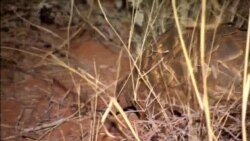ໂຕຫຼິ່ນ ແມ່ນສັດທີ່ຖືກລັກລອບຄ້າຂາຍຢ່າງຜິດກົດໝາຍຫຼາຍທີ່ສຸດໃນໂລກ. ສາຍພັນ
8 ຊະນິດ ຂອງສັດລ້ຽງລູກດ້ວຍນໍ້ານົມ ທີ່ສວຍງາມ ແຕ່ຫາຈັບໄດ້ຍາກດັ່ງກ່າວນີ້ ສາ
ມາດພົບເຫັນໄດ້ ໃນທະວີບ ອາຟຣິກາ ແລະ ເອເຊຍຕາເວັນອອກສຽງໃຕ້, ແຕ່ສັດດັ່ງ
ກ່າວແມ່ນໄດ້ຖືກລ່າ ຫຼາຍເຖິງ 300 ໂຕ ໃນແຕ່ລະມື້, ເຊິ່ງມີຈຸດໝາຍປາຍທາງໄປຍັງ
ຕະຫຼາດ ໃນປະເທດ ຫວຽດນາມ ແລະ ຈີນ, ບ່ອນທີ່ຊີ້ນຂອງມັນ ຖືວ່າ ມີລາຄາແພງ
ແລະ ເກັດຂອງມັນກໍເຊື່ອວ່າ ເປັນຢາດິວິເສດ. ຕອນນີ້ບັນດານັກຄົ້ນຄວ້າ ໃນຣາຊະ
ອານາຈັກອັງກິດ ໄດ້ຫວັງ ທີ່ຈະແກ້ໄຂບັນຫາການລ່າໂຕຫຼິ່ນນີ້ ຜ່ານເທັກໂນໂລຈີ ກວດ
ລາຍມື ທີ່ພິເສດ ເຊິ່ງຖືກອອກແບບມາ ເພື່ອລະບຸຕົວພວກລັກລ່າສັດ ຈຳພວກນີ້ ແລະ
ນຳເອົາພວກເຂົາມາລົງໂທດ. ນັກຂ່າວວີໂອເອ ຈູລີ ຕາໂບ ມີລາຍງານເຊິ່ງ ພຸດທະ
ສອນ ຈະນຳເອົາລາຍລະອຽດມາສະເໜີທ່ານ ໃນອັນດັບຕໍ່ໄປ.
ໂຕ ຫຼິ່ນ ແມ່ນສັດທີ່ຂີ້ອາຍ ແລະ ເລິກລັບ. ພວກມັນມີເກັດທີ່ໜາ ແລະ ຊ້ອນກັນຢູ່ ຊຶ່ງ
ຄ້າຍຄືກັນກັບໂຕ ອາມາດິລໂລ ເພື່ອປ້ອງກັນໂຕຈາກພວກທີ່ຈະມາທຳຮ້າຍມັນ. ແຕ່
ຄວາມຮຽກຮ້ອງຕ້ອງການເກັດຂອງພວກມັນ ແມ່ນສູງຫຼາຍຢູ່ໃນຕະຫຼາດທີ່ຜິດກົດ
ໝາຍ ເຊິ່ງເປັນໄພຂົ່ມຂູ່ຕໍ່ການມີຊີວິດຢູ່ຂອງພວກມັນ.
ແຕ່ຕອນນີ້ ບັນດານັກຄົ້ນຄວ້າໃນປະເທດ ອັງກິດ ໄດ້ມີຄວາມຊຳນິຊຳນານ ໃນການ
ນຳໃຊ້ວິທີການ ກ່ຽວກັບ ການເກັບກຳລາຍມືຂອງພວກນັກລ່າໂຕຫຼິ່ນ ຈາກເກັດຂອງ
ສັດດັ່ງກ່າວ.
ທ່ານນາງ ແຈັກ ຣີດ, ຜູ້ຊ່ຽວຊານດ້ານນິຕິເວດ ຈາກມະຫາວິທະຍາ ໄລ ຜອດສມັທ໌
ກ່າວວ່າ “ຕອນທີ່ພວກເຮົານຳມັນຂຶ້ນມາ, ເອົາເກັດກັບຄືນມາ ແລະ ເອົາມັນວາງລົງ
ແລະ ເອົາມັນໃສ່ໃນເຄື່ອງສະແກນນໍ້າເມືອກ ແລະ ເມື່ອມັນປາກົດອອກມາ ຂ້າພະ
ເຈົ້າກໍຫຼົງເວົ້າອອກມາວ່າ, ວາວ! ພວກເຮົາໄດ້ລາຍມືຈາກເກັດນັ້ນ ແລ້ວ ພວກເຮົາກໍ
ຕື່ນເຕັ້ນຫຼາຍ.”
ກຸ່ມນັກນິຕິເວດ ໄດ້ໃຊ້ມາດຕະຖານສາກົນ ສຳລັບການເກັບກູ້ຫຼັກຖານຢູ່ຈຸດເກີດເຫດ
ອາຊະຍາກຳ ເຊັ່ນ ແຜ່ນແຈລ ຫຼືນໍ້າເມືອກ ເຊິ່ງຖືກກົດໃສ່ເກັດຂອງໂຕຫຼິ່ນ ແລ້ວ ສະ
ແກນມັນ, ເພື່ອເປີດເຜີຍຂໍ້ມູນລາຍມືຂອງຄົນຜູ້ທີ່ໄດ້ຈັບມັນ.
ຂັ້ນຕອນການໃຊ້ທີ່ງ່າຍໆ, ແລະ ບໍ່ແມ່ນເທັກໂນໂລຈີລະດັບສູງນີ້ ເຮັດໃຫ້ມັນໃຊ້ງານ
ໄດ້ງ່າຍຂຶ້ນກວ່າເກົ່າ.
ດຣ. ພອລ ສມິທ໌ ຈາກສູນວິວັດທະນາການນິຕິເວດ ຂອງມະຫາວິທະຍາໄລ ຜອດສມັດ
ກ່າວວ່າ “ມັນອາດຈະບໍ່ສົມບູນເທົ່າກັບຢູ່ໃນຫ້ອງທົດລອງ ຫຼື ໃນຈຸດເກີດເຫດອາຊະ
ຍາກຳ ທີ່ຢູ່ໃນການຄວບຄຸມ ແຕ່ເຈົ້າຍັງສາມາດລວບລວມຫຼັກຖານ ແລະ ມັນກໍຍັງມີ
ຂັ້ນຕອນ ແລະ ວັດຖຸຕ່າງໆ ທີ່ເຈົ້າສາມາດໃຊ້ ແລະ ໄດ້ຫຼັກຖານໄວຂຶ້ນ, ນຳເອົາມັນໄປ
ສະຖານທີ່ໆປອດໄພ ແລະ ທຳການວິເຄາະມັນຢູ່ທີ່ນັ້ນ.”
ບັນດາຜູ້ປະສານງານໂຄງການນີ້ ລວມມີ ອົງການການກຸສົນ ສັງຄົມສັດວິດທະຍາ
ແຫ່ງ ລອນດອນ, ອົງການຄວບຄຸມເຂດຊາຍແດນ ສະຫະຣາຊະອານາຈັກ ຫຼື UK
Border Force, ຜູ້ທີ່ສາມາດສະ
ໜອງເກັດຂອງໂຕຫຼິ່ນທີ່ຖືກຫ້າມພາຍໃຕ້ສົນທິສັນຍາ ກ່ຽວກັບ ການຄ້າຂາຍສັດປ່າ
ແລະ ພືດໃກ້ຈະສູນພັນຂ້າມປະເທດ ຫຼື CITES.
ຜົນກະທົບຈາກການຄ້າຂາຍໂຕຫຼິ່ນຢ່າງຜິດກົດໝາຍ ອາດມີຢ່າງໃຫຍ່ຫຼວງ.
ທ່ານ ແກຣ້ນ ມິລເລີ, ເຈົ້າໜ້າທີ່ອາວຸໂສ ຄວບຄຸມເຂດຊາຍແດນ, ກຸ່ມ CITES ຢູ່ສະ
ໜາມບິນ ຮີໂທຣ ກ່າວວ່າ “ສິ່ງທີ່ມັນເຮັດກໍແມ່ນ ມັນໄດ້ເຮັດໃຫ້ພວກເຮົາມີຄວາມສາ
ມາດ ທີ່ຈະຜູກມັດຜູ້ກໍ່ອາຊະຍາກຳໃສ່ເກັດຂອງໂຕຫຼິ່ນ, ສະນັ້ນມັນຈຶ່ງບໍ່ແມ່ນພຽງແຕ່
ພວກເຮົາໄດ້ພົບເຫັນເກັດໂຕຫຼິ່ນເທົ່ານັ້ນ ແຕ່ພວກເຮົາຍັງສາມາດທີ່ຈະສືບສວນສອບ
ສວນພວກທີ່ລັກລອບຄ້າຂາຍມັນນຳດ້ວຍ.”
ຖ້າບໍ່ມີການແກ້ໄຂບັນຫາແລ້ວ, ພວກໂຕຫຼິ່ນກໍຈະສູນພັນໄປ.
ທ່ານ ຄຣິສ ແຣນຊຳ, ຜູ້ບໍລິຫານໂຄງການ ອາຟຣິກາ ທີ່ອົງການ ສັງຄົມສັດວິທະຍາ
ແຫ່ງ ລອນດອນ ກ່າວວ່າ “ມັນມີບ່ອນທີ່ພວກເຮົາໄດ້ເຫັນໂຕຫຼິ່ນຖືກກວາດລ້າງໄປ
ຈົນກ້ຽງແລ້ວ ແລະ ມັນກໍຈະສືບຕໍ່ເກີດຂຶ້ນ. ສະນັ້ນພວກເຮົາຈຶ່ງຕ້ອງໄດ້ຫາວິທີ ເພື່ອ
ປາບປາມການຄ້າຂາຍ, ປາບປາມຄວາມຮຽກຮ້ອງຕ້ອງການ, ຢຸດການລ່າ ເພື່ອຈະ
ຮັບປະກັນວ່າ ສັດຊະນິດນີ້ ຈະສາມາດຢູ່ລອດ ຢູ່ໃນປ່າໄດ້.”
ທ່ານນາງ ເຄີສຕີ ເຮັນເດີສັນ ແມ່ນຜູ້ປະສານງານ ການໂຄສະນາ ອາວຸໂສ ທີ່ອົງການ
PETA ຫຼື ປະຊາຊົນ ເພື່ອການປິ່ນປົວ ດ້ານສິນທຳ ກ່ຽວກັບ ສັດ.
ທ່ານນາງ ເຄີສຕີ ກ່າວວ່າ “ຄືວ່າມັນບໍ່ແມ່ນແຕ່ພວກເຮົາ ຈະຂ້າພວກມັນ ແລະ ໃຊ້
ອະໄວຍະວະຂອງພວກມັນ ສຳລັບທຳນຽມທີ່ແນະນຳໃນທາງທີ່ຜິດ ຫຼື ວິທະຍາສາດ
ຫຼອກລວງເທົ່ານັ້ນ, ແຕ່ສັດພວກນີ້ ແມ່ນໃກ້ຈະສູນພັນ ແລະ ພວກເຮົາຄວນ ແລະ
ຕ້ອງເຮັດຫຼາຍຢ່າງຕື່ມອີກ ເພື່ອປົກປ້ອງພວກມັນ.”
ການລັກລອບຄ້າຂາຍສັດປ່າ ແລະ ພືດ ແມ່ນປະເພດອາຊະຍາກຳທີ່ໃຫຍ່ທີ່ສຸດຂອງ
ໂລກເປັນອັນດັບ 4, ຕາມຫຼັງການຄ້າມະນຸດ, ຢາເສບຕິດ ແລະ ອາວຸດປືນ, ດ້ວຍ
ການກະປະມານວ່າ ມີມູນຄ່າລະຫວ່າງ 17 ແລະ 23 ພັນລ້ານໂດລາໃນແຕ່ລະປີ.
Pangolins are the world's most illegally trafficked animal. Eight species of the beautiful but elusive mammals can be found in Africa and Southeast Asia, but as many as 300 are poached every day, destined for markets in Vietnam and China, where their meat is considered a delicacy and their scales believed to have medicinal properties. Now a team of researchers in the UK are hoping to deter pangolin poaching through specialized fingerprint technology that's designed to identify poachers and bring them to justice. VOA's Julie Taboh explains.
Pangolins are shy, secretive animals. They have a coat of thick, overlapping scales -- much like an armadillo -- to protect themselves against predators. But demand for those scales is driving an illegal market which is threatening their very existence.
But now researchers in England have perfected a method of recovering the fingerprints of pangolin poachers from the animals' scales.
"When we first brought it up, brought the scales back and loaded one up and put it into the gel scan and when it came up I just went, wow! We've got a fingerprint off that and we were thrilled."
The forensic team used the international standard for recovering crime scene evidence -- gel pads -- which are pressed onto scales, and then scanned, to reveal ridge details of the person who had held them.
The easy-to-use, low-tech process makes it easier to prosecute.
"It might not be as perfect as it is in a laboratory or in a controlled crime scene but you can still gather evidence and there are still methods and materials you can use that will quickly get that evidence, get it to a safe environment and do the analysis there."
Project collaborators included the Zoological Society of London and the UK Border Force, who were able to supply pangolin scales banned under the Convention on International Trade in Endangered Species of Wild Fauna and Flora ((CITES)).
The impact on the illegal trade in pangolins would be massive.
"What it does is it gives us the ability to tie organized criminals to the pangolin scales, so that not only are we finding the pangolin scales but we are able to investigate those that are trafficking."
Without a remedy, pangolins will become extinct.
"There are places where we've seen pangolins being wiped out already and that's just going to continue to happen. So we need to find ways to tackle the trade, tackle the demand, stop the poaching in order to ensure this species can survive in the wild."
Kirsty Henderson is Senior Campaign Coordinator at PETA -- People for the Ethical Treatment of Animals.
"So not only are we killing them and using their body parts for little more than misguided tradition or pseudo-science, but these animals are endangered and we should be -- and need to be -- doing a lot more to protect them.
Wildlife and plant trafficking is the world's fourth biggest crime category -- behind human trafficking, drugs and firearms, with an estimated value of between $17 and $23 billion dollars annually.





